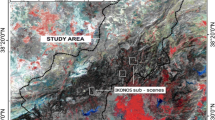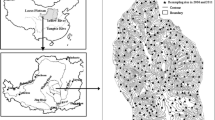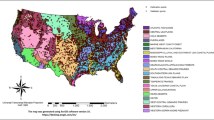Abstract
Soil organic carbon and nitrogen (SOC-N) dynamics are indicative of the human-induced disturbances of the terrestrial ecosystems the quantification of which provides insights into interactions among drivers, pressures, states, impacts, and responses in a changing environment. In this study, a process-based model was developed to simulate the eight monthly outputs of net primary productivity (NPP), SOC-N pools, soil C:N ratio, soil respiration, total N emission, and sediment C-N transport effluxes for cropland, grassland, and forest on a hectare basis. The interaction effect of the climate change drivers of aridity, CO2 fertilization, land-use and land-cover change, and best management practices was simulated on high altitude ecosystems from 2018 to 2070. The best management practices were developed into a spatiotemporally composite index based on SOC-N stock saturation, 4/1000 initiative, and RUCLE-C factor. Our model predictions differed from the remotely sensed data in the range of − 64% (underestimation) for the cropland NPP to 142% (overestimation) for the grassland SOC pool as well as from the global mean values in the range of − 97% for the sediment C and N effluxes to 60% for the total N emission from the grassland. The interaction exerted the greatest negative impact on the monthly sediment N efflux, total N emission, and soil respiration from forest by − 90.5, − 82.7, and − 80.3% and the greatest positive impact on the monthly sediment C effluxes from cropland, grassland, and forest by 139.3, 137.1, and 133.3%, respectively, relative to the currently prevailing conditions.









Similar content being viewed by others
References
Ballabio, C., Lugato, E., Fernández-Ugalde, O., Orgiazzi, A., Jones, A., Borrelli, P., Montanarella, L., & Panagos, P. (2019). Mapping LUCAS topsoil chemical properties at European scale using Gaussian process regression. Geoderma, 355, 113912. https://doi.org/10.1016/j.geoderma.2019.113912.
Churkina, G., Zaehle, S., Hughes, J., Viovy, N., Chen, Y., Jung, M., Heumann, B. W., Ramankutty, N., Heimann, M., & Jones, C. (2010). Interactions between nitrogen deposition, land cover conversion, and climate change determine the contemporary carbon balance of Europe. Biogeosciences, 7(9), 2749–2764. https://doi.org/10.5194/bg-7-2749-2010.
Elmendorf, S. C., Henry, G. H. R., Hollister, R. D., Björk, R. G., Bjorkman, A. D., Callaghan, T. V., Collier, L. S., Cooper, E. J., Cornelissen, J. H. C., Day, T. A., Fosaa, A. M., Gould, W. A., Grétarsdóttir, J., Harte, J., Hermanutz, L., Hik, D. S., Hofgaard, A., Jarrad, F., Jónsdóttir, I. S., Keuper, F., Klanderud, K., Klein, J. A., Koh, S., Kudo, G., Lang, S. I., Loewen, V., May, J. L., Mercado, J., Michelsen, A., Molau, U., Myers-Smith, I. H., Oberbauer, S. F., Pieper, S., Post, E., Rixen, C., Robinson, C. H., Schmidt, N. M., Shaver, G. R., Stenström, A., Tolvanen, A., Totland, Ø., Troxler, T., Wahren, C. H., Webber, P. J., Welker, J. M., & Wookey, P. A. (2012). Global assessment of experimental climate warming on tundra vegetation: Heterogeneity over space and time. Ecology Letters, 15, 164–175. https://doi.org/10.1111/j.1461-0248.2011.01716.x.
Ernakovich, J. G., Hopping, K. A., Berdanier, A. B., Simpson, R. T., Kachergis, E. J., Steltzer, H., & Wallenstein, M. D. (2014). Predicted responses of arctic and alpine ecosystems to altered seasonality under climate change. Global Change Biology, 20, 3256–3269. https://doi.org/10.1111/gcb.12568.
Evrendilek, F., & Wali, M. K. (2001). Modelling long-term C dynamics in croplands in the context of climate change: A case study from Ohio. Environmental Modelling & Software, 16(4), 361–375. https://doi.org/10.1016/S1364-8152(00)00089-X.
Goudriaan, J. (1992). Biosphere structure, carbon sequestering potential and the atmospheric 14C carbon record. Journal of Experimental Botany, 43, 1111–1119. https://doi.org/10.1093/jxb/43.8.1111.
Goudriaan, J., & Zadoks, J. C. (1995). Global climate change: Modelling the potential responses of agro-ecosystems with special reference to crop protection. Environmental Pollution, 87, 215–224. https://doi.org/10.1016/0269-7491(94)P2609-D.
Grace, P. R., Ladd, J. N., Robertson, G. P., & Gage, S. H. (2006). SOCRATES—A simple model for predicting long-term changes in soil organic carbon in terrestrial ecosystems. Soil Biology & Biochemistry, 38, 1172–1176. https://doi.org/10.1016/j.soilbio.2005.09.013.
He, X., Liang, J., Zeng, Y., & Li, X. (2019). The effects of interaction between climate change and land-use/ cover change on biodiversity-related ecosystems services. Global Challenges, 1800095. https://doi.org/10.1002/gch2.201800095,
Helliwell, R. C., Ferrier, R. C., & Kernan, M. R. (2001). Interaction of nitrogen deposition and land use on soil and water quality in Scotland: Issues of spatial variability and scale. Science of the Total Environment, 265, 51–63. https://doi.org/10.1016/S0048-9697(00)00649-5.
Kimball, B. A., Mauney, J. R., Nakayama, F. S., Idso, S. B. (1993). Effects of increasing atmospheric CO on vegetation. In J. Rozema, H. Lambers, S. C. Van de Geijn, M. L. Cambridge (Eds.), CO and biosphere. Advances in vegetation science, vol 14. Dordrecht: Springer.
Koven, C. D., Hugelius, G., Lawrence, D. M., & Wieder, W. R. (2017). Higher climatological temperature sensitivity of soil carbon in cold than warm climates. Nature Climate Change, 7, 817–822. https://doi.org/10.1038/nclimate3421.
Lieth, H. (1975). Modelling the primary productivity of the world. In H. Lieth & R. H. Whittaker (Eds.), Primary productivity of the biosphere (pp. 237–263). New York: Springer-Verlag.
O’Rourke, S. M., Angers, D. A., Holden, N. M., & McBratney, A. B. (2015). Soil organic carbon across scales. Global Change Biology, 21, 3561–3574. https://doi.org/10.1111/gcb.12959.
Parton, W. J., Scurlock, J. M. O., Ojima, D. S., Gilmanov, T. G., Scholes, R. J., Schimel, D. S., Kirchner, T., Menaut, J. C., Seastedt, T., Garcia Moya, E., Kamnalrut, A., & Kinyamario, J. I. (1993). Observations and modeling of biomass and soil organic matter dynamics for the grassland biome worldwide. Global Biogeochemical Cycles, 7, 785–809. https://doi.org/10.1029/93GB02042.
Peters, M. K., Hemp, A., Appelhans, T., Becker, J. N., Behler, C., Classen, A., Detsch, F., Ensslin, A., Ferger, S. W., Frederiksen, S. B., Gebert, F., Gerschlauer, F., Gütlein, A., Helbig-Bonitz, M., Hemp, C., Kindeketa, W. J., Kühnel, A., Mayr, A. V., Mwangomo, E., Ngereza, C., Njovu, H. K., Otte, I., Pabst, H., Renner, M., Röder, J., Rutten, G., Schellenberger Costa, D., Sierra-Cornejo, N., Vollstädt, M. G. R., Dulle, H. I., Eardley, C. D., Howell, K. M., Keller, A., Peters, R. S., Ssymank, A., Kakengi, V., Zhang, J., Bogner, C., Böhning-Gaese, K., Brandl, R., Hertel, D., Huwe, B., Kiese, R., Kleyer, M., Kuzyakov, Y., Nauss, T., Schleuning, M., Tschapka, M., Fischer, M., & Steffan-Dewenter, I. (2019). Climate–land-use interactions shape tropical mountain biodiversity and ecosystem functions. Nature, 568, 88–92. https://doi.org/10.1038/s41586-019-1048-z.
Piao, S., Wang, X., Wang, K., Li, X., Bastos, A., Canadell, J. G., Ciais, P., Friedlingstein, P., & Sitch, S. (2020). Interannual variation of terrestrial carbon cycle: Issues and perspectives. Global Change Biology, 26(1), 300–318. https://doi.org/10.1111/gcb.14884.
Raich, J. W., & Tufekcioglu, A. (2000). Vegetation and soil respiration: Correlations and controls. Biogeochemistry, 48, 71–90. https://doi.org/10.1023/A:1006112000616.
Shirato, Y. (2017). Calculating changes in soil organic carbon in Japanese agricultural land by IPCC-tier 3 modeling approach: Use of modified Rothamsted carbon model. In proceedings of the global symposium on soil organic carbon (pp. 177).
Stehfest, E. (2005). Modelling of global crop production and resulting N2O emissions. Dissertation, Universitaet Kassel, Kassel, Germany.
Stehfest, E., van Zeist, W., Valin, H., Havlik, P., Popp, A., Kyle, P., et al. (2019). Key determinants of global land-use projections. Nature Communications, 10, 2166. https://doi.org/10.1038/s41467-019-09945-w.
Trabucco, A., & Zomer, R. (2019). Global aridity index and potential evapotranspiration (ET0) climate database v2. Figshare. Dataset: https://figshare.com/articles/Global_Aridity_Index_and_Potential_Evapotranspiration_ET0_Climate_Database_v2/7504448/3
Vanmaercke, M., Poesen, J., Verstraeten, G., de Vente, J., & Ocakoglu, F. (2011). Sediment yield in Europe: Spatial patterns and scale dependency. Geomorphology, 130(3–4), 142–161. https://doi.org/10.1016/j.geomorph.2011.03.010.
Watt, M. S., & Palmer, D. J. (2012). Use of regression kriging to develop a carbon: Nitrogen ratio surface for New Zealand. Geoderma, 183, 49–57. https://doi.org/10.1016/j.geoderma.2012.03.013.
Xiong, X., Grunwald, S., Myers, D. B., Ross, C. W., Harris, W. G., & Comerford, N. B. (2014). Interaction effects of climate and land use/land cover change on soil organic carbon sequestration. Science of the Total Environment, 493, 974–982. https://doi.org/10.1016/j.scitotenv.2014.06.088.
Yin, R., Eisenhauer, N., Schmidt, A., Gruss, I., Purahong, W., Siebert, J., & Schädler, M. (2019). Climate change does not alter land-use effects on soil fauna communities. Applied Soil Ecology, 140, 1–10. https://doi.org/10.1016/j.apsoil.2019.03.026.
Acknowledgments
We thank Haluk Fidan and Ceren Bozkurt for their help with the analysis of soil samples in laboratory.
Funding
This research was funded by the Turkish Scientific and Technological Research Council (TUBITAK) under the Grant number: 117Y193.
Author information
Authors and Affiliations
Contributions
This article is extracted from Kadir Yildiz’s MSc thesis. Nusret Karakaya and Fatih Evrendilek were co-supervisors for his MSc thesis and responsible for conceptualization, securing the TUBITAK funding, and drafting the article. Seref Kilic was responsible for soil sampling, analysis and mapping.
Corresponding author
Ethics declarations
Conflict of interest
The authors declare that they have no conflict of interest.
Ethics approval
Not applicable.
Consent
Not applicable.
Additional information
Publisher’s note
Springer Nature remains neutral with regard to jurisdictional claims in published maps and institutional affiliations.
Rights and permissions
About this article
Cite this article
Yildiz, K., Karakaya, N., Kilic, S. et al. Interaction effects of the main drivers of global climate change on spatiotemporal dynamics of high altitude ecosystem behaviors: process-based modeling. Environ Monit Assess 192, 457 (2020). https://doi.org/10.1007/s10661-020-08430-y
Received:
Accepted:
Published:
DOI: https://doi.org/10.1007/s10661-020-08430-y




